Key takeaways:
- Messy datasets offer valuable insights; approaching them as a puzzle can reveal underlying patterns and stories.
- Common data issues include inconsistent formats, outliers, and missing values, each with unique implications for analysis.
- Data cleaning is crucial for ensuring accuracy, reliability, and a solid foundation for further research.
- Establishing a systematic cleaning protocol, documenting processes, and regular reviews enhance data quality and integrity over time.
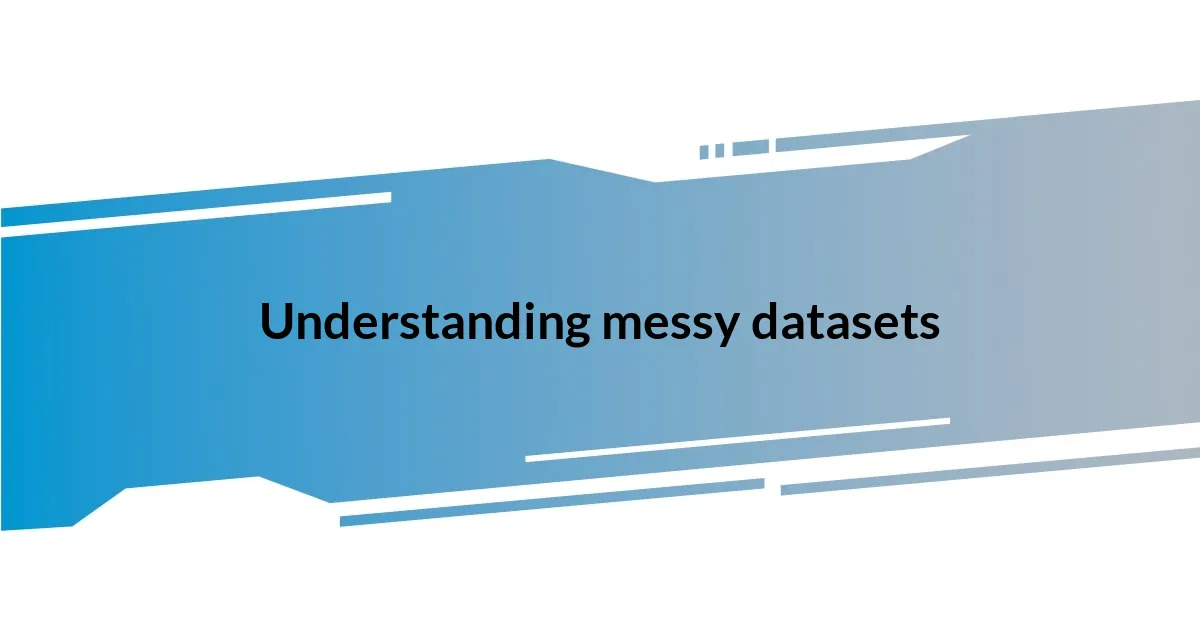
Understanding messy datasets
Messy datasets can feel overwhelming at first glance, but they often tell a story deeper than their chaotic appearance. I remember diving into a project where the data was riddled with duplicates, outliers, and missing values. It was frustrating, yet exhilarating, as I began to realize that each imperfection was an opportunity to clean and refine the dataset, revealing insights I might have otherwise missed.
Have you ever looked at a dataset so cluttered that you wondered where to even begin? I certainly have. I felt like I was searching for a needle in a haystack. It’s easy to lose sight of the goal amidst the noise, but it’s crucial to understand that these inconsistencies can provide invaluable context about the data’s collection process or user behavior, enriching our analysis when tackled correctly.
When I encounter a messy dataset, I try to think of it like a puzzle. I know that every misplaced piece has a purpose. Each entry may represent a user’s unique experience, and it intrigues me to uncover the reasons behind the mess. Understanding that these datasets are often the result of human error or different data entry methods can soften the initial frustration and turn the cleanup process into a compelling journey of discovery.
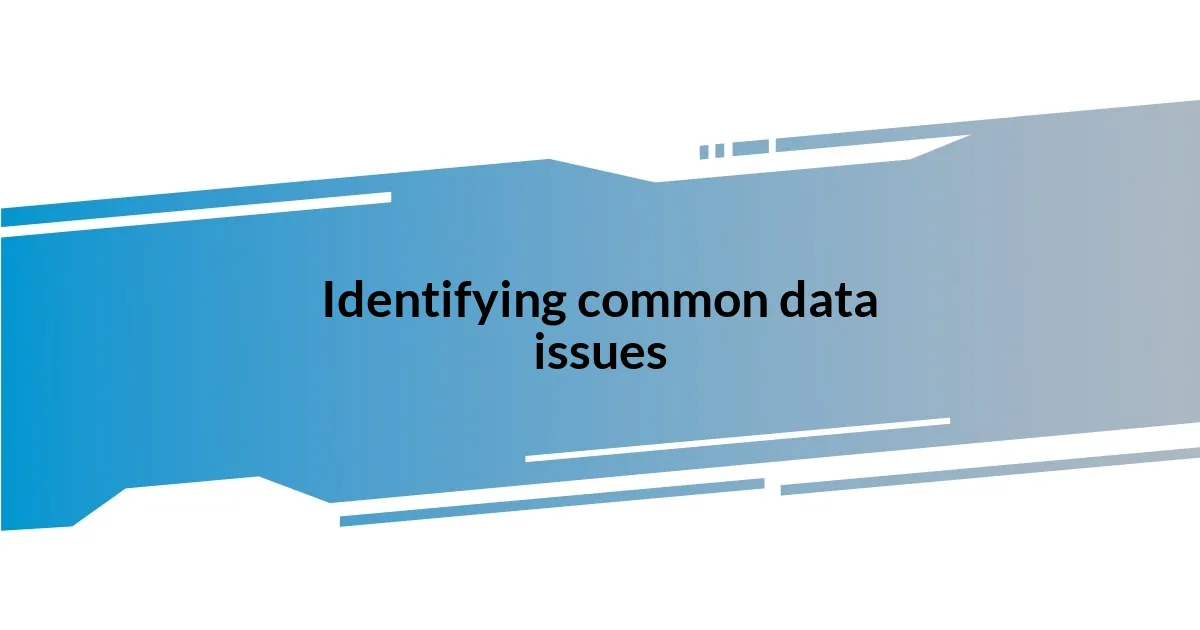
Identifying common data issues
When I start sifting through a messy dataset, identifying common data issues often feels like peeling back layers of an onion. One time, I encountered a dataset filled with inconsistent date formats. Some entries were in MM/DD/YYYY while others were in DD/MM/YYYY. This discrepancy led to a lot of confusion. I remember the moment I recognized the pattern—it was like a light bulb went off. Realizing that this confusion stemmed from users across different regions gave me insight into the dataset’s origin and user base, which was an unexpected bonus.
Another frequent issue I come across is the presence of outliers, which can skew the dataset’s overall analysis. In a past project, a few entries reflecting astronomical sales numbers stood out starkly against the others. Initially, I thought these might be erroneous values, but upon further investigation, I uncovered that these numbers were legitimate sales during a promotional event. This experience taught me that while outliers can be problematic, they can also highlight critical events worth exploring.
Lastly, missing values often raise red flags. I recall a dataset where crucial demographic information was missing for a number of users. At first, it felt like a setback. However, as I dug deeper, I realized these gaps offered a chance to explore why certain individuals opted out of sharing their details. This exploration led to meaningful insights about privacy concerns and user trust. It’s moments like these that remind me that every data issue has a story waiting to be uncovered.
| Common Data Issue | Description |
|---|---|
| Inconsistent Formats | Data entries that vary in format, such as date and currency formats, leading to confusion. |
| Outliers | Data points that are significantly higher or lower than the rest, potentially skewing analyses. |
| Missing Values | Absence of data in fields, which can hide important user insights. |
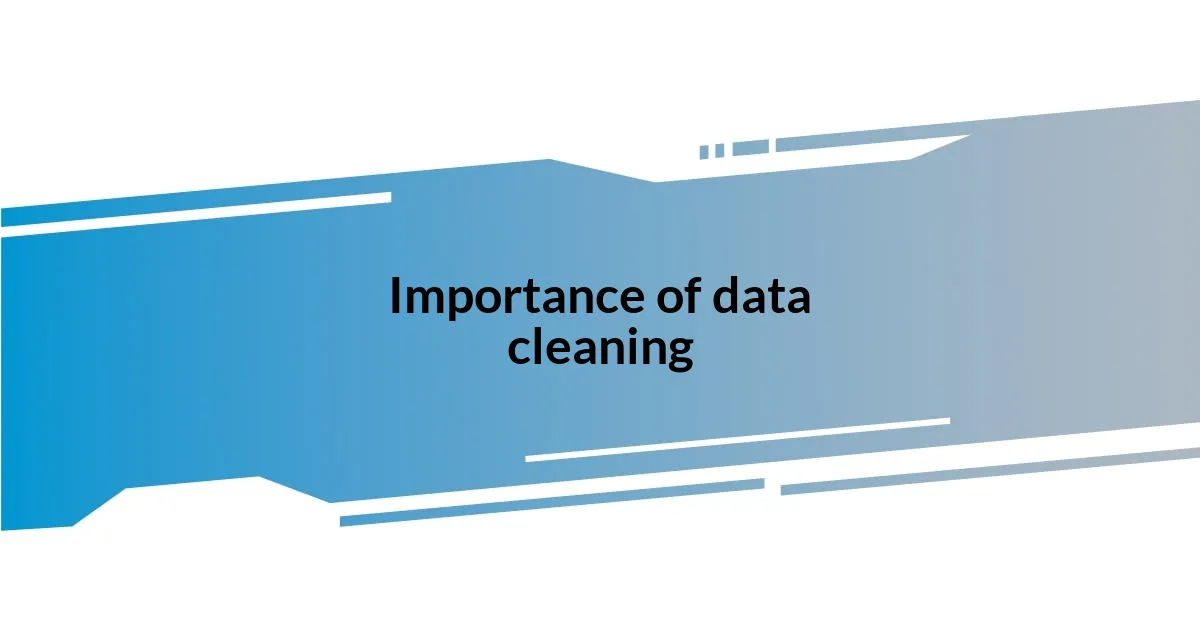
Importance of data cleaning
Cleaning data isn’t just a technical necessity; it’s a foundational step that profoundly impacts the integrity of your analysis. I distinctly remember a time when I neglected this stage out of sheer eagerness to start visualizing results. The revelations I found were inaccurate and misleading, all because I hadn’t prioritized data cleaning. That experience reminded me that clean data is like a canvas for a masterpiece—without it, the final picture can be distorted or worse, meaningless.
Understanding the importance of data cleaning means recognizing its effects on decision-making. Consider these points:
- Accuracy: Clean datasets yield accurate insights, enabling informed decisions.
- Reliability: Trustworthy conclusions stem from data free of errors and biases.
- Efficiency: Streamlined data allows for faster analysis, saving time and resources.
- Analysis Basis: Detailed and clean data serves as a solid foundation for further research and exploration.
Each of these aspects reinforces that data cleaning is not just about tidying up; it’s about fostering a deeper understanding of the patterns and insights that can only emerge from refined data.
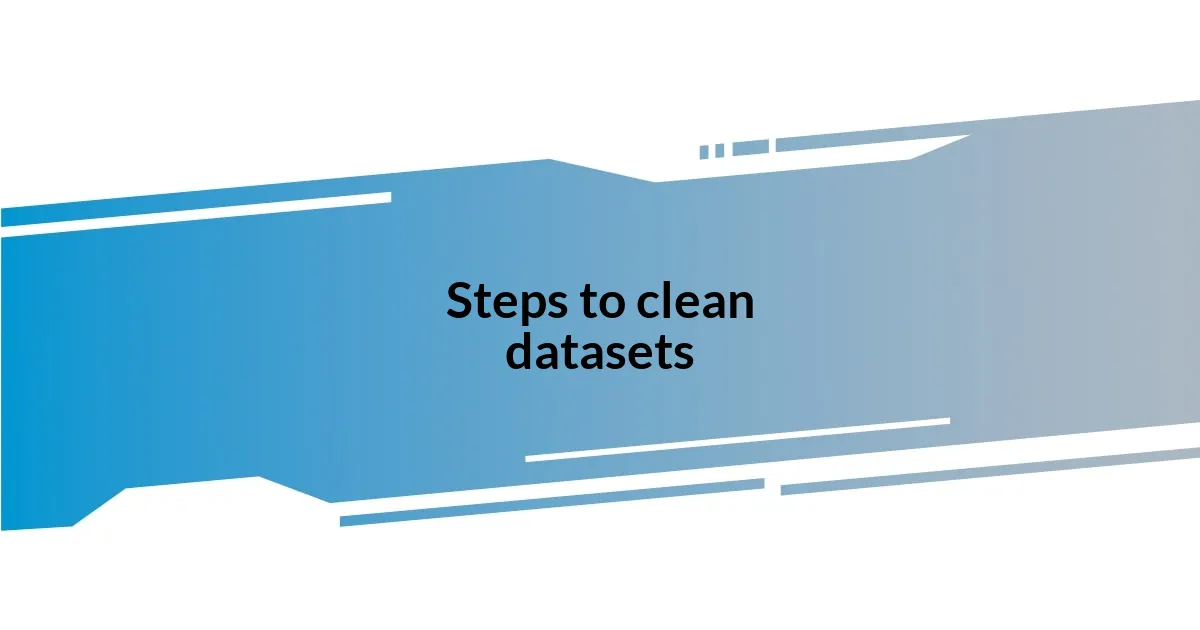
Steps to clean datasets
Once I’ve identified the common data issues, the next pivotal step is to standardize those formats. I vividly remember taking on a project where customer addresses were input in varying styles. Some had abbreviations while others were fully spelled out, and, honestly, it felt chaotic. So, I decided to create a function that transformed all address components into a uniform structure. Not only did this simplify things, but it also made future analyses incredibly smoother.
The following step is to handle missing values; this can be a bit tricky. I faced a dataset where nearly 20% of users didn’t provide their ages, and at first, I panicked. Should I just fill those gaps with the average age? Instead, I opted for a more thoughtful approach—analyzing patterns in the missing data helped me realize that younger users often skipped age-related questions. This opened up a valuable discussion about target demographics and user engagement, turning what could have been a setback into a golden opportunity.
Finally, I always advise fellow data enthusiasts to test the cleaned dataset thoroughly. Once, after cleaning a particularly messy dataset, I assumed everything was squared away and dove into analysis. Shockingly, I discovered that several entries were still incorrectly formatted. It served as a wake-up call! It’s essential to go back and validate your efforts, ensuring that the cleaning process didn’t just superficially cover up issues but truly resolved them. So remember, what good is a polished surface if the foundation is shaky?
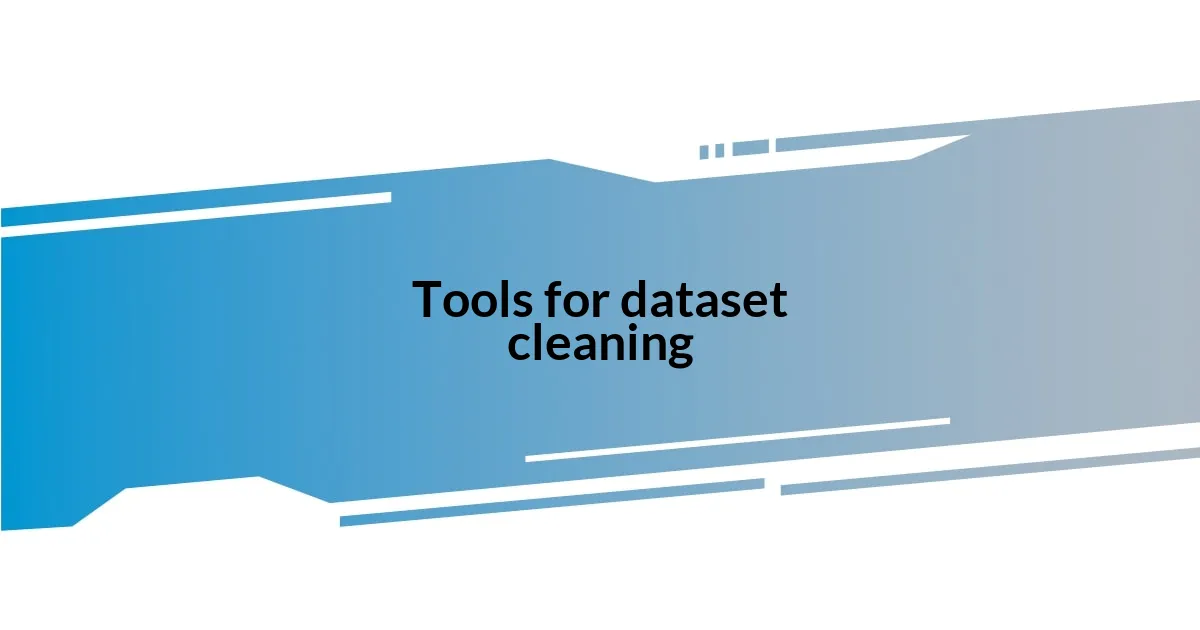
Tools for dataset cleaning
When it comes to tools for dataset cleaning, I’ve found that software like OpenRefine is a game-changer. I remember diving into a particularly chaotic dataset with wildly inconsistent entries. OpenRefine helped me visualize the patterns and errors so I could make informed decisions on how to clean them up. Its facet filters allowed me to quickly identify anomalies that I would have missed otherwise.
For those who prefer a more code-oriented approach, Python’s Pandas library is indispensable. I can’t emphasize enough how many hours I’ve saved using its data manipulation capabilities. Just the other day, I was wrestling with a dataset that had duplicate entries galore. A few simple lines of code helped me identify and remove those duplicates, making my analysis far more reliable. Isn’t it fascinating how a few lines of code can dramatically enhance your data integrity?
Lastly, don’t overlook the power of Excel for data cleaning, especially for smaller datasets. I once used Excel to apply conditional formatting to highlight any outliers, and the visual cues were immensely helpful in spotting errors quickly. Have you ever found yourself staring at a sea of numbers, wondering where to even start? Excel’s filtering and sorting features made the process intuitively simple, transforming what could have been a daunting task into something manageable and clear.
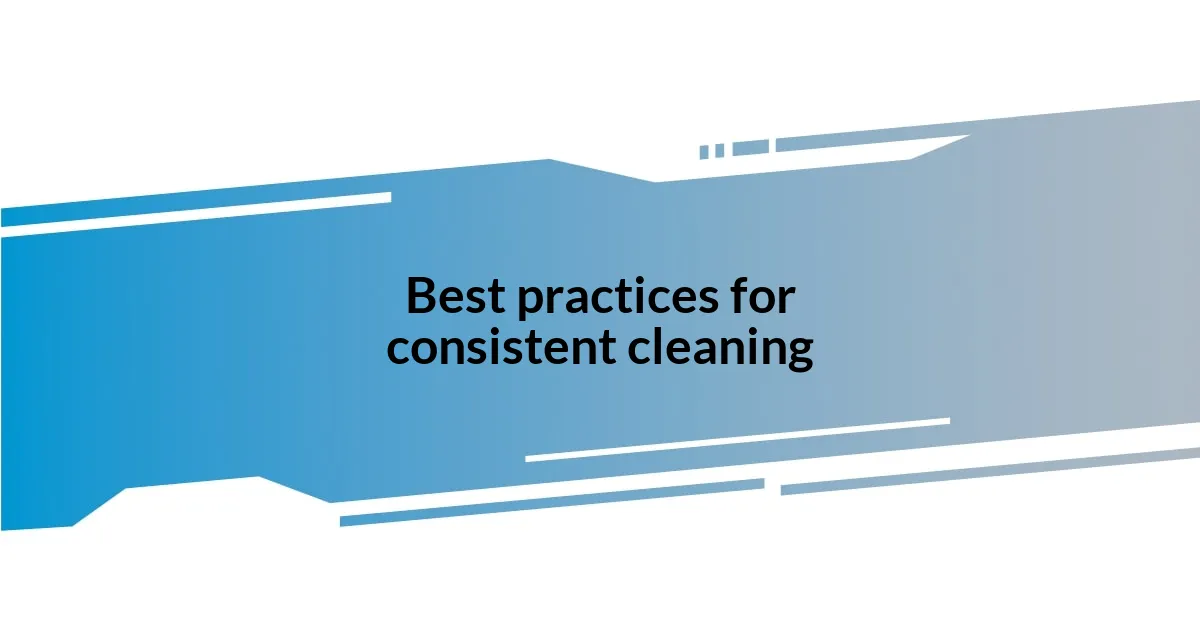
Best practices for consistent cleaning
To achieve consistent cleaning of messy datasets, I’ve learned that developing a clear protocol is key. In one of my earlier projects, I created a step-by-step checklist that I followed meticulously. This structured approach not only ensured that I didn’t overlook any vital data aspects, but it also made me feel more in control as I navigated through a jumble of entries. Have you ever felt lost in the sheer volume of your data? Having that checklist felt like a reliable guide through the chaos.
Another best practice involves documenting each cleaning step. I remember experimenting with different methods for handling outliers in a sales dataset, trying various techniques to balance accuracy and representation. When I later reviewed my notes, I realized how valuable they were in guiding my thought process. By documenting my actions, I was able to explain my choices to teammates clearly and even revisit certain decisions when faced with similar issues later.
Lastly, establishing a routine for consistent reviews can be a game-changer. I set aside time each week to revisit clean datasets and check for any emerging issues. There was one instance when I discovered that new entries had introduced inconsistencies that I hadn’t initially accounted for. Regular reviews kept me on my toes and ensured that the datasets maintained their integrity over time. It’s a reminder that data cleaning isn’t a one-off task; it’s an ongoing commitment to quality and clarity.
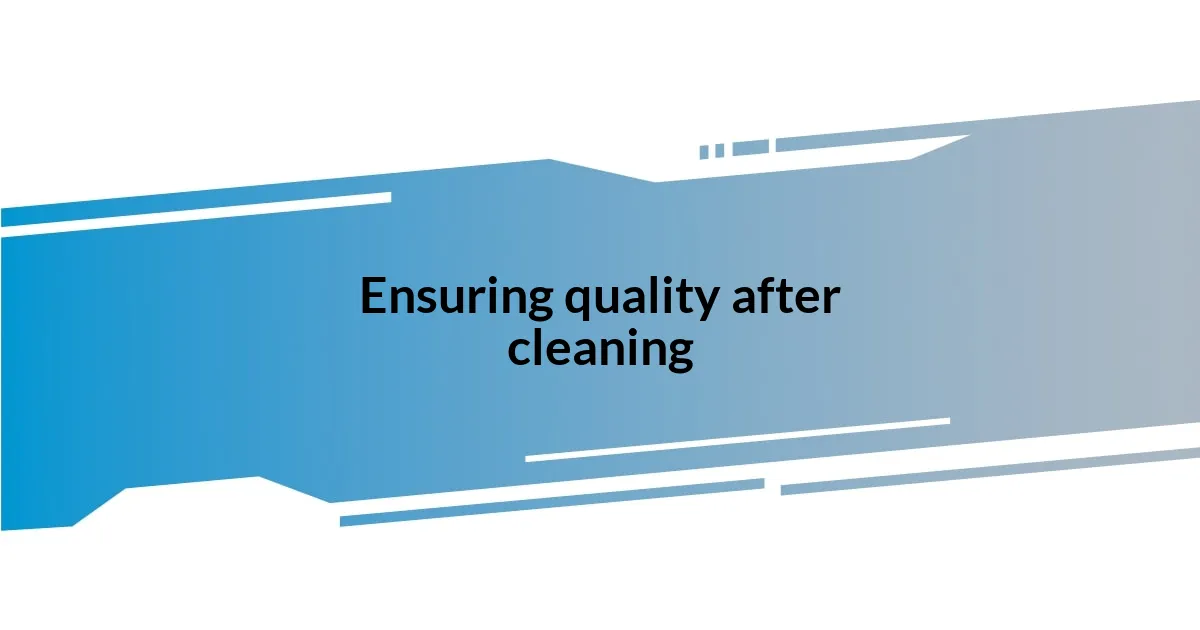
Ensuring quality after cleaning
After cleaning a dataset, the real test of quality begins. I’ve felt that moment of anxiety when I thought I’d successfully cleaned everything, only to discover lingering issues. One time, after polishing off a dataset, I performed a final validation check and found a few fields still had unexpected null values. It was a sigh of relief to catch these before any analysis, but it emphasized the need for a thorough quality assurance process post-cleaning.
Consistency is vital even after cleaning. I recall a project where I skimped on a quality check because I believed everything was in order. The ensuing analysis revealed several overlooked discrepancies. That experience taught me to implement automated scripts that run diagnostic checks. Have you ever relied solely on your instincts? My journey has shown me that a systematic check, even when things appear pristine, can save countless hours of rework.
Additionally, establishing key performance indicators (KPIs) can guide you in ensuring your dataset remains high quality over time. When I worked on a marketing analysis, I crafted KPIs that measured variations in data accuracy and completeness. These metrics provided a helpful framework for ongoing assessment and informed my future cleaning techniques. I can’t stress enough how these indicators serve as a safety net, allowing for continuous improvement and peace of mind. How about you? What methods do you use to gauge the effectiveness of your data cleaning efforts?